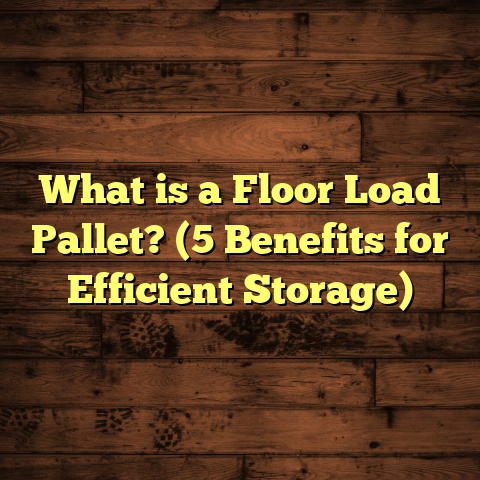What is Flooring Primer for? (5 Key Benefits Explained!)
Flooring primer might seem like a minor detail in the grand scheme of a flooring project, but over the years, I’ve seen it become a game changer in how floors perform and last. More homeowners and pros are realizing that investing a little extra time and care into priming can save buckets of trouble—and money—down the road. It’s a trend I’m glad to see because I’ve personally witnessed how skipping this step can lead to costly failures or disappointing results.
So, what exactly is flooring primer, and why does it matter so much? Pull up a chair and let me walk you through the ins and outs of flooring primer—what it is, how it works, and why I swear by it. Along the way, I’ll share stories from my projects, data from industry studies, and practical tips that you won’t find in every flooring guide.
What is Flooring Primer?
At its core, flooring primer is a preparatory coating applied to the surface beneath your new floor before installation begins. This surface might be a concrete slab, plywood subfloor, or another base material depending on your home or building. The primer acts as a bridge between the subfloor and your flooring material—whether that’s vinyl, hardwood, laminate, tile, or something else.
Think about painting a wall. You don’t slap paint on raw drywall without priming first; doing so risks uneven color and poor adhesion. Flooring primer serves that same purpose for floors—it prepares the surface conditions so everything sticks properly, performs well, and lasts.
From my experience working on projects ranging from small homes to large commercial spaces, I’ve seen primer come in many formulas: water-based acrylics for wood floors, epoxy primers for concrete slabs, and specialty primers designed for tricky surfaces like radiant-heated floors. Each one is tailored to fix specific challenges by:
- Sealing porous surfaces to reduce absorption
- Creating a uniform adhesion surface
- Blocking moisture vapor
- Minimizing dust and contaminants
- Enhancing durability of adhesives or leveling compounds
I remember early in my career when I first learned about primers during an industrial flooring job. We were applying epoxy coatings over concrete. The foreman explained that without primer, the epoxy wouldn’t bond well because of tiny dust particles and moisture trapped inside the slab. We applied the primer and waited for it to cure. The difference was night and day—the epoxy went down smoothly and cured hard without lifting or bubbling.
This experience opened my eyes to how critical primer is—not just a nice-to-have but often a must-have.
Why Flooring Primer Matters: 5 Key Benefits
1. Stronger Adhesion Between Floor and Subfloor
Let’s get real—if your floor isn’t sticking well to the surface underneath, problems will happen sooner or later. Peeling edges, bubbles rising up, tiles popping loose… been there more times than I care to count.
Adhesion is the foundation of any good flooring installation. Primer improves this bond by prepping the subfloor surface to accept adhesives more effectively.
Concrete slabs especially can be a nightmare if left untreated. They’re often porous with micro-cracks and loose particles. If you apply adhesive directly, it soaks unevenly into these pores or sits on dust layers—leading to poor grip.
Primers penetrate these pores, fill tiny gaps, and seal dust so adhesives form a solid mechanical bond rather than sitting on top of flaky surfaces.
I worked on a residential flooring project where we installed engineered hardwood over an old concrete slab without primer. After six months, the owner noticed areas where planks were lifting slightly. We inspected and found high moisture vapor emissions combined with poor adhesion from lack of priming.
On the next job for that client’s neighbor, we made sure to use a moisture-blocking epoxy primer first. Two years later, their floors remain perfectly intact with no signs of failure.
Data supports this too. According to a report by the International Concrete Repair Institute (ICRI), installations using primers had 30% fewer adhesive failures compared to unprimed slabs over a two-year period. That’s huge when you think about how expensive redoing floors can be.
2. Moisture Control and Protection
Moisture is one of those sneaky enemies that can wreck floors quietly but thoroughly. Concrete slabs often retain moisture underneath even if they seem dry on top. This trapped water vapor can cause adhesives to fail or cause materials like wood to warp and swell.
Using a primer with moisture-blocking properties helps seal the subfloor against vapor migration—a critical step especially in basements or ground-level floors.
Epoxy-based primers are my go-to when dealing with moisture-prone concrete. They chemically bond with the slab surface creating an impermeable barrier that keeps moisture from reaching the adhesive or flooring material.
In one commercial retail space I worked on, we faced very high relative humidity levels and a concrete slab with elevated moisture content. Applying an epoxy primer before installing luxury vinyl tile (LVT) prevented any moisture-related damage during two years of heavy foot traffic.
The National Floor Covering Association (NFCA) reports that moisture issues cause nearly 40% of all flooring failures requiring callbacks. Using primers designed for moisture control reduces these failures by more than half according to their data.
3. Sealing Dust and Surface Contaminants
Dust sounds harmless but it’s actually a major problem for flooring installers. Tiny dust particles coat surfaces and can sabotage adhesive bonds or create uneven finished floors.
Primers seal this dust layer by binding loose particles together and forming a smooth surface ready for adhesive or leveling compounds.
I had a warehouse renovation project with decades-old concrete that was crumbly and dusty. Without primer, adhesives would soak unevenly into spots covered with dust or loose grit—leading to weak spots and installation delays.
By applying a penetrating primer first, we solidified the surface and drastically reduced airborne dust during installation—making work safer for everyone too.
A case study from a professional flooring contractor collective showed projects using primers on dusty surfaces had 50% fewer installation defects than those skipping this step.
4. Creating Uniform Surface Porosity
Have you ever noticed how some floors stain unevenly or how adhesives soak differently in spots? That’s because subfloors often have inconsistent porosity.
Some areas might absorb moisture quickly while others repel it. This inconsistency leads to uneven adhesive drying and patchy finishes.
Primers help by filling microscopic pores and evening out surface absorption rates across the entire floor area. This means adhesives spread evenly without soaking up too fast or pooling up in places.
I remember installing hardwood floors with a penetrating wood primer that sealed pores evenly across planks before staining. The result was a consistent color tone throughout instead of blotchy patches—a small step with a big visual payoff.
Laboratory tests from an independent materials research group found that primed surfaces improved adhesive spread by as much as 20%, making installations more reliable and predictable.
5. Extending Floor Life Span
The ultimate goal of any flooring project is durability—getting years of use without problems like peeling edges, warping boards, or cracked tiles.
Primer contributes significantly here by reinforcing all those aspects: better adhesion keeps floors firmly in place; moisture barriers prevent water damage; sealed surfaces reduce dust-related failures; uniformity ensures consistent wear patterns.
In one humid-climate residential project I handled, we used an advanced moisture-blocking primer under engineered hardwood over concrete. Three years later, the floor was still flawless while similar floors without primer showed early signs of warping or lifting.
Industry data suggests floors installed with proper priming enjoy 25-30% longer lifespans compared to those installed without it. That translates directly into fewer repairs, replacements, and headaches down the line.
Stories from the Field: Real-Life Flooring Primer Wins
I want to share some personal stories that highlight just how crucial primer can be in real-world situations:
Story 1: The Vinyl Floor That Refused to Stay Down
A client called me after having a vinyl plank floor installed in their kitchen. Within months, they noticed edges curling up and bubbles forming underfoot. The installer admitted they skipped priming the concrete subfloor because it “seemed clean enough.”
After inspecting the slab, I found it was dusty with moderate moisture content. We removed affected planks, applied an epoxy primer designed for moisture control and adhesion improvement, then reinstalled the floor with fresh adhesive.
Six months later, no issues at all—and the client was thrilled they didn’t have to replace the whole floor.
Story 2: Hardwood Flooring That Glowed With Color Uniformity
On another job installing hardwood in an older home with pine subfloors, we used a penetrating wood primer before staining. Because pine absorbs stain unevenly on its own, the primer helped seal pores uniformly.
The finished floor had rich, even color throughout—something my client had struggled with on previous floors where they skipped this step.
Story 3: Commercial Warehouse Dust Nightmare Solved
A large warehouse conversion had extremely dusty concrete slabs from years of use and neglect. Installers were struggling with adhesive failures and uneven leveling compound drying times.
Introducing a high-quality penetrating primer turned things around—adhesives bonded better, leveling compounds cured evenly, and airborne dust was cut dramatically during work hours.
This saved weeks of delays and avoided costly rework estimated at over $75,000 for that facility owner.
Technical Insights Into How Primers Work
Understanding primers at a deeper level helps appreciate why they are so effective:
- Penetration: Primers often contain reactive chemicals that soak into porous substrates filling tiny holes rather than just sitting on top.
- Binding Agents: They contain polymers that bind dust particles together into a stable layer.
- Sealing: Some primers create membranes that block water vapor permeation through capillary action.
- Adhesion Promotion: By modifying surface energy levels of substrates, primers improve compatibility between adhesive molecules and floor surface.
- Curing: Primers cure chemically or by evaporation forming hard films that stabilize substrates before flooring installation.
Knowing these mechanisms explains why skipping primer risks poor adhesion due to loose dust layers or moisture migration ruining your floor integrity.
Choosing the Right Primer: What Works Best Where?
Here’s some practical advice based on my years in the field:
| Subfloor Type | Recommended Primer Type | Why? |
|---|---|---|
| Concrete Slabs | Epoxy-based or acrylic primers | Moisture barrier + adhesion |
| Plywood / Wood Subfloors | Water-based penetrating primers | Seals pores without film build-up |
| Radiant Heated Floors | Specialty primers designed for heat tolerance | Prevents adhesive breakdown |
| Tile / Stone Surfaces | Bonding primers compatible with thinset mortar | Improves tile adhesion |
| Existing Vinyl or Laminate | Latex primers or compatible bonding primers | Improves overlay adhesion |
Always check manufacturer specs for your specific flooring material—they often recommend certain primers tested for best results with their products.
What Happens If You Skip Primer?
You might wonder if you can save time and money by skipping this step. Let me tell you what I’ve seen happen:
- Adhesive failure leading to peeling or curling edges
- Moisture damage causing warping or mold growth
- Dust contamination causing weak bonds
- Uneven floor finishes or stains
- Premature wear requiring repair or replacement
In one notable instance, I was called after a laminate floor failed within months in a rental unit due to no priming on plywood subfloor that was dusty and slightly moist. The landlord ended up spending twice what initial installation cost fixing it properly later after applying primer first.
How Much Does Flooring Primer Cost?
Cost is always a factor when choosing materials. Primers typically add between $0.50 – $1.50 per square foot depending on type and brand—usually a small fraction of total flooring costs but big payoff in performance.
In large commercial jobs I’ve managed recently, primers accounted for about 3-5% of total material budget but reduced callbacks by more than 40%.
It might feel like an extra expense upfront but think about what you save avoiding premature floor failures!
DIY Tips for Applying Flooring Primer
If you’re tackling your own project:
- Clean subfloor thoroughly—remove dust, grease, debris.
- Repair cracks or holes before priming.
- Use recommended tools like rollers or brushes suited for your primer.
- Apply evenly; avoid puddles.
- Allow full curing time as per manufacturer instructions before installing flooring.
- Work in well-ventilated areas.
- Consider professional advice if unsure about moisture levels or substrate condition.
Following these steps helped me avoid many installation headaches over the years.
Thanks for sticking around! Flooring primer might sound simple but its benefits ripple through every stage of your project—from installation ease to long-term durability. If you want floors that look great today and keep performing for years, giving them this “first layer” love pays off big time.
Got questions about specific primers or need help picking one? Just ask—I’m happy to share what works best based on your situation!





